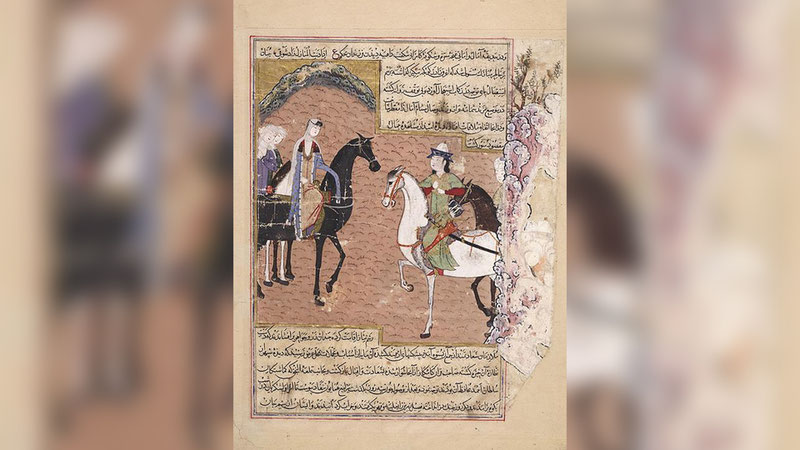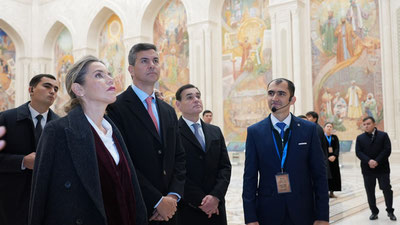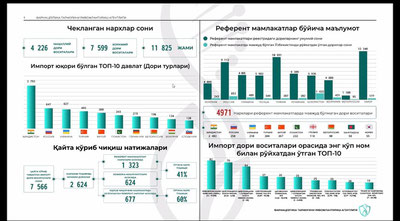Saray Mulk Khanum, Gauhar Shad Begum, Shad Mulk, Khadija Begum, Khanzada Begum, Gulbadan Begum... We have heard a lot about the princesses belonging to the Timurid palace, read about them in historical sources and books. However, in no source do we find a clear depiction of their appearances. We have only imagined their appearances from the descriptions given to them. As part of the work carried out within the framework of forming the exposition of the Center of Islamic Civilization in Uzbekistan, scientists witnessed sensational news related to Saray Mulk Khanum, a Timurid princess deemed worthy of the special respect of Amir Temur and entitled as "Katta Khanum" or "Bibi Khanum" here.
When talking about the princesses of the Timurid palace, the name of Saray Mulk Khanum, Amir Temur's life partner, who was deemed worthy of his special respect for her high intelligence and beauty, and entitled as "Katta Khanum" or "Bibi Khanum", is specifically mentioned.
The acknowledgment of the Spanish traveler Clavijo
By studying the history of our land, including the unique prototypes and beauty secrets of the Timurid princesses' attire, one can realize that splendor has always been inherent in the Uzbek statehood. Moreover, Turanian women stand out not only for their beauty but also for their intelligence, having their own word and strategy in the political arena. This is confirmed by the work of the Spanish traveler Clavijo, "Travel Diary to Samarkand – the Court of Amir Temur": “After everyone took their place, from one of the tents came out Bibi Khanum, the grand wife of Sahibkiran. She wore a very wide dress made of red fabric with golden threads, so long that about fifteen young maidens followed her to hold it. Her face was so heavily powdered that it seemed like a white sheet of paper from afar. This white zinc ointment was applied for protection against the sun. Bibi Khanum’s face was covered with a thin white fabric, she had a red fabric headgear, from which a thin fabric fell to her shoulders. The long headgear was adorned with precious stones and gems. The lady’s hair was very black, falling to her shoulders. Women here prefer their hair to be black in color and sometimes dye it to that shade. Next to Bibi Khanum was a person holding a parasol over her to shield her from the sun. The parasol was made of white silk, sewn in the shape similar to a tent. Bibi Khanum stepped up to the podium where Sahibkiran was sitting, and sat next to him.”
The princess who led to Amir Temur receiving the “Kuragan” title
Saray Mulk Khanum was born in 1341, a daughter of the Mongol khans from the Chagatai Ulus, Kozan Khan. When Kozan Khan was dethroned and killed, Saray Mulk Khanum was only five years old. Upon reaching puberty, in 1355, she was married to the grandson of Amir Qazoqan, Amir Husayn.
In 1370, after defeating and killing Amir Husayn in battle, Amir Temur took control of Transoxiana. Among several wives from Amir Husayn’s harem, Amir Temur chose Saray Mulk Khanum, the daughter of Kozan Khan, and after a three-month waiting period, married her. After marrying her, Amir Temur was honored with the title “Kuragan”. "Kuragan" is a Mongolian word, meaning “son-in-law”. Indeed, because Saray Mulk Khanum was the daughter of one of the Mongol khans, Amir Temur acquired the name "Amir Temur Kuragan".
The tradition of the Timurids
It was a tradition in the court of Sahibkiran to entrust the upbringing of princes born in the palace to Saray Mulk Khanum. As clear examples, Shahrukh Mirzo and Khalil Sultan, nurtured in art and literature, and Mirzo Ulugbek’s love for science, literature, and music. This tradition was preserved during the era of the Baburids as well. The high culture of the nation that nurtured women like Gauhar Shad Begum, Shahrukh Mirzo’s wife; Kutlugh Nigar Khanum, Babur's mother; Esan Dawlat Begum, Babur's grandmother; Khanzada Begum, Babur’s sister; Nur Jahan, Jahangir's wife; Jahan Ara, architect-artist daughter of Shah Jahan; Mumtaz Mahal Arjumand Banu, Shah Jahan’s wife; along with poets and wise state officials of later times is evident.
 Until today, many may not know of Saray Mulk Khanum’s portraiture. A miniature in Sharaf al-Din Ali Yazdi's manuscript of the "Zafarnama" held at Seattle Art Museum in the USA, depicts Saray Mulk Khanum's journey from Samarkand to the Timur encampment in northwest Iran with Shahrukh ibn Temur and Khalil Sultan ibn Mihran Shah. According to art historian Priscilla Soucek, the depiction of Saray Mulk Khanum in Amir Temur’s biography in Yazdi’s "Zafarnama" assembled after her death shows her in a miniature with one of Temur’s sons - young Shahrukh. This depiction, created thirty years after Saray Mulk Khanum's death, allows us to observe that among her steeds, her stature, honor, and respect were considerably high, especially when compared to her stepson Shahrukh who was 10 years old at that time. Historical sources mentioning these women sometimes reflect in manuscript paintings as well. Sharaf al-Din Ali Yazdi's manuscript version of the "Zafarnama" also captures events from the lives of Saray Mulk Khanum and Khanzada Begum.
Until today, many may not know of Saray Mulk Khanum’s portraiture. A miniature in Sharaf al-Din Ali Yazdi's manuscript of the "Zafarnama" held at Seattle Art Museum in the USA, depicts Saray Mulk Khanum's journey from Samarkand to the Timur encampment in northwest Iran with Shahrukh ibn Temur and Khalil Sultan ibn Mihran Shah. According to art historian Priscilla Soucek, the depiction of Saray Mulk Khanum in Amir Temur’s biography in Yazdi’s "Zafarnama" assembled after her death shows her in a miniature with one of Temur’s sons - young Shahrukh. This depiction, created thirty years after Saray Mulk Khanum's death, allows us to observe that among her steeds, her stature, honor, and respect were considerably high, especially when compared to her stepson Shahrukh who was 10 years old at that time. Historical sources mentioning these women sometimes reflect in manuscript paintings as well. Sharaf al-Din Ali Yazdi's manuscript version of the "Zafarnama" also captures events from the lives of Saray Mulk Khanum and Khanzada Begum.
This miniature serves as a unique source for materializing the imaginative perceptions related to the appearances of the Timurid princesses.






